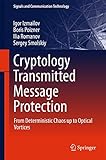Cryptology Transmitted Message Protection [electronic resource] : From Deterministic Chaos up to Optical Vortices / by Igor Izmailov, Boris Poizner, Ilia Romanov, Sergey Smolskiy.
By: Izmailov, Igor [author.] .
.
Contributor(s): Poizner, Boris [author.] | Romanov, Ilia [author.]
| Romanov, Ilia [author.] | Smolskiy, Sergey [author.]
| Smolskiy, Sergey [author.] | SpringerLink (Online service)
| SpringerLink (Online service) .
.
Material type:  BookSeries: Signals and Communication Technology: Publisher: Cham : Springer International Publishing : Imprint: Springer, 2016Edition: 1st ed. 2016.Description: XXVIII, 364 p. 225 illus., 19 illus. in color. online resource.Content type: text Media type: computer Carrier type: online resourceISBN: 9783319301259.Subject(s): Data structures (Computer science)
BookSeries: Signals and Communication Technology: Publisher: Cham : Springer International Publishing : Imprint: Springer, 2016Edition: 1st ed. 2016.Description: XXVIII, 364 p. 225 illus., 19 illus. in color. online resource.Content type: text Media type: computer Carrier type: online resourceISBN: 9783319301259.Subject(s): Data structures (Computer science)Introduction -- Radio Electronic and Optical Chaos Oscillators Applicable for Information Protection -- Simulation of the Radio Electronic Communication System on the Basis of the Chaotic Oscillator with Nonlinearity in the Form of Parabolas Composition -- Simulation of Data Ciphering and Deciphering with the Help of Nonlinear Interferometers in the Optical System of Synchronous Chaotic Communication -- Optical Vortices in Non-Ring Interferometer and a Model of the Digital Communication System -- Conclusion.
This book presents methods to improve information security for protected communication. It combines and applies interdisciplinary scientific engineering concepts, including cryptography, chaos theory, nonlinear and singular optics, radio-electronics and self-changing artificial systems. It also introduces additional ways to improve information security using optical vortices as information carriers and self-controlled nonlinearity, with nonlinearity playing a key "evolving" role. The proposed solutions allow the universal phenomenon of deterministic chaos to be discussed in the context of information security problems on the basis of examples of both electronic and optical systems. Further, the book presents the vortex detector and communication systems and describes mathematical models of the chaos oscillator as a coder in the synchronous chaotic communication and appropriate decoders, demonstrating their efficiency both analytically and experimentally. Lastly it discusses the cryptologic features of analyzed systems and suggests a series of new structures for confident communication.


There are no comments for this item.